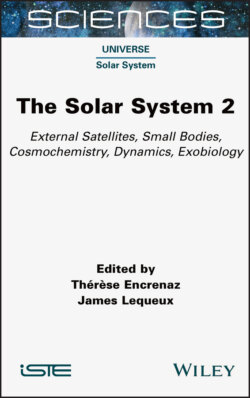Читать книгу The Solar System 2 - Группа авторов - Страница 9
Оглавление
Preface
Thérèse ENCRENAZ1 and James LEQUEUX2
1 LESIA, Paris Observatory, PSL University, Paris, France
2 LERMA, Paris Observatory, PSL University, Paris, France
The aim of this book is to present a global and synthetic vision of planetology to the reader, in other words, the study of the objects of the Solar System. This is an ambitious objective, because planetology has undergone considerable development over the last decades and, today, it presents interfaces with multiple disciplines. In our approach, we have chosen to prioritize the study of physico-chemical processes, in order to shed light on the mechanisms that are at the origin of the formation of the objects of the Solar System, or that are responsible for their evolution.
This work is a continuation of the book Le Système solaire (T. Encrenaz, J.-P. Bibring, M. Blanc, M.-A. Barucci, F. Roques, P. Zarka), published in 2003 by EDP-Sciences and CNRS Editions, in the “Savoirs Actuels” collection. This work was itself the third edition of Le Système solaire (T. Encrenaz, J.-P. Bibring, M. Blanc), first published in 1987 in co-edition with InterEditions and CNRS Editions. More than 30 years after this first edition, a complete revision of the work was essential: during this period, planetology has undergone several revolutions. The first ones, both realized thanks to ground-based telescopes, were the discovery of the first trans-Neptunian objects other than Pluto in 1992, and then, in 1995, the discovery of the first extrasolar planets around solar-type stars. The 1990, 2000 and 2010 decades saw the deep exploration of the planets Jupiter and Saturn and their system, with the Galileo and Cassini space missions. The beginning of the 21st century saw the resumption of the Mars exploration program with the launch of numerous probes, both in orbit and on the surface of the planet. Venus and Mercury were also visited by space probes, as well as several asteroids including Ceres and Vesta; lastly, the comet Churyumov-Gerasimenko was the subject of extended exploration thanks to the spectacular European Rosetta mission. Meanwhile, the first detections of exoplanets paved the way to a new field of research in full development, that of exoplanetology. The extraordinary variety of objects discovered around other stars, both in terms of their orbits and their physical parameters, has raised new questions about the formation scenarios of planetary systems; the discovery of the phenomenon of migration in these systems has encouraged new research on the origin and evolution of our own Solar System. The discovery of a large proportion of rocky exoplanets – the “super-Earths” – has also stimulated work in exobiology with the ultimate goal of finding life on one of these exoplanets. Over the last 30 years, planetary scientists have forged increasingly close links with other astronomers (who are at the origin of the discovery of exoplanets), but also with geophysicists, chemists and biologists interested in the problem of the emergence of life, on Earth or elsewhere.
The plan of the work follows the main course of the previous works. The first volume opens with three general chapters. Chapter 1 presents a general description of the Solar System. Chapter 2 describes the environment of the Solar System, the formation of stars and planets within the disks as well as the extrasolar planets. Chapter 3 deals with the interaction of the Solar System with the interplanetary medium. Chapters 4 and 5 present a description of telluric and giant planets. The second volume presents the satellites and rings of giant planets (Chapter 1), comets, asteroids and dwarf planets (Chapter 2), meteorites and cosmochemistry (Chapter 3), the formation and dynamics of the Solar System (Chapter 4), the origin of life and extraterrestrial life (Chapter 5), and lastly, the methods of study of the Solar System (Chapter 6). Almost all of these chapters are composed of original texts. In the few cases where we have relied on texts from the last edition of the Solar System (2003), we have explicitly mentioned it. We thank J.-P. Bibring, M. Blanc, M.-A. Barucci and P. Zarka for their contributions in the previous book.
This book is intended primarily for students of planetology, astrophysics and geophysics at the undergraduate and graduate level, but we hope that it can be read with benefit by all scientists, researchers and engineers wishing to deepen their knowledge of planetology.
June 2021
